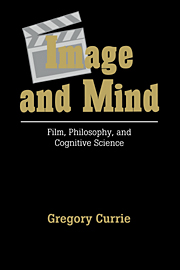Book contents
- Frontmatter
- Contents
- Preface
- Acknowledgements
- Film, 1895–1995
- Image and mind
- Introduction: the essence of cinema
- Part I Representation in film
- Part II Imagination
- Chapter 5 Imagination, the general theory
- Chapter 6 Imagination, personal and impersonal
- Chapter 7 Travels in narrative time
- Part III Interpretation
- In conclusion
- Named propositions
- Bibliography
- Index
Chapter 6 - Imagination, personal and impersonal
Published online by Cambridge University Press: 28 October 2009
- Frontmatter
- Contents
- Preface
- Acknowledgements
- Film, 1895–1995
- Image and mind
- Introduction: the essence of cinema
- Part I Representation in film
- Part II Imagination
- Chapter 5 Imagination, the general theory
- Chapter 6 Imagination, personal and impersonal
- Chapter 7 Travels in narrative time
- Part III Interpretation
- In conclusion
- Named propositions
- Bibliography
- Index
Summary
A film makes us feel like eye-witnesses of the events which it portrays.
Victor PerkinsCinema is a medium in which fictions are presented pictorially. In this way, its fictions differ from those of the novel and other linguistic forms. But to characterize the difference between the pictorial and the linguistic just at the point of delivery would be to leave us with something important unexplained: the distinctive experience of pictorial, and in particular cinematic, fictions. Watching movies is very different from reading novels. It is also different from watching plays. Any adequate theory of cinema will have to account for the differences. That theory must tell us not only what is distinctive about the delivery of cinematic fictions but also about their reception – and about the connection between the two. It will not be sufficient simply to say that viewers of a film are required to imagine various things, and that the film is constructed so as to guide them in their imaginings, for that is true of all fictions in whatever media. I have my own story to tell about what is distinctive about cinematically induced imaginings, but it will appear strange and unmotivated unless it is arrived at by the elimination of more familiar and perhaps initially more plausible rivals. So I begin with what I take to be the main rival account which I distil, by a process of rational reconstruction, from the writings of film theorists of various times and persuasions. When we see what is wrong with that account we shall have reason to look on my own proposal with some favour.
- Type
- Chapter
- Information
- Image and MindFilm, Philosophy and Cognitive Science, pp. 164 - 197Publisher: Cambridge University PressPrint publication year: 1995



